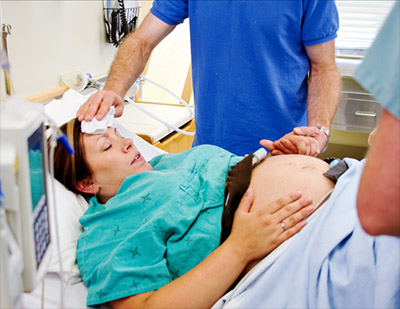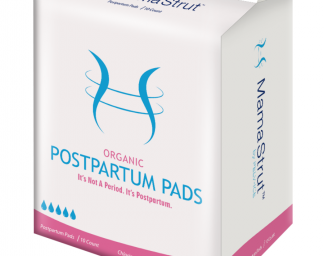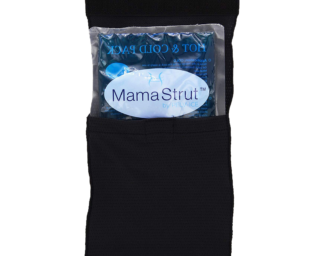
 Question & Answer with Anesthesiologist Dr. Farzad Mahjoubi.
Question & Answer with Anesthesiologist Dr. Farzad Mahjoubi.
What do you think is the most misunderstood concept about an epidural during labor?
The biggest misconception about epidurals is that the procedure often results in spinal cord injury. Epidurals for labor actually are done at the lumbar level, below where the spinal cord ends. So unless the anesthesiologist is completely off, it’s pretty much impossible to hit the spinal cord during an epidural. Another misconception is that epidurals can cause back pain following childbirth. This may occur if the anesthesiologist hits the spinal column or nerve roots during the procedure. But again, this is a rare occurrence in properly trained hands. Back pain following childbirth usually occurs from the baby’s head passing through the pelvic brim, or from the extra weight carried during pregnancy, weak abdominal muscles or body posture.
What do you wish your patients knew about preparing for an epidural?
The best way to prepare is to be educated on the patient’s role in the epidural. It’s important for the patient to remain calm and sit still during the few minutes the anesthesiologist is looking for the right space. An anxious patient may move at the slightest touch instead of remaining motionless. Also, proper positioning as shown by the obstetric nurse and anesthesiologist will help an epidural go smoothly.
Are there any medical conditions, predispositions, or other factors that would prevent moms-to-be from considering an epidural?
Any woman who has undergone back surgery should tell her doctor. Often, the anatomy is altered or hardware is placed during spinal surgery, and the anesthesiologist needs to take this into consideration during an epidural procedure. Moderate to severe Scoliosis should also be mentioned to the doctor for the same reason. There are multiple medical conditions that may affect epidural placement, such as bleeding disorders, systemic infection, altered brain anatomy, allergies to medications used during an epidural, heart problems such as valve disorders, and liver disorders that may impede in metabolism of medications used. However, the hospital staff and obstetrician are most likely aware of these conditions prior to the procedure, and such information is also noted in the medical chart.
What are the newest advances in anesthesia for new moms today?
Though not much has changed, there are new types of epidural syringes that aid anesthesiologists in finding the epidural space, but most of the physicians I know don’t rely on this syringe and rarely use it. Since the epidural works amazingly well, no major advances have been seen on the obstetric anesthesia stage in recent years.
Like any other medical treatment, epidurals come with risks. What suggestions do you have to reduce the risks?
As mentioned before, the more obese a patient is, the harder it is to do an epidural. Adhering to a healthy diet and lifestyle to avoid or reduce obesity helps greatly. And again, educating oneself about the epidural procedure will help decrease any related associated anxiety.
What are the warning signs for any adverse reactions to an epidural and how should the patient deal with those reactions?
One uncommon, but debilitating, side effect of epidurals is a post-dural puncture headache. If the needle goes in a little too far, causing a small leakage in the cerebrospinal fluid, patients can get a severe headache that may last for months. If this happens, go the nearest emergency room and let them know you recently had an epidural. The ER physician should know that this is likely due to a PDPH (post-dural puncture headache). The anesthesiologist will be called and can immediately remedy the headache by performing a “Blood Patch,” a procedure where the patient’s own blood is used to patch up the small leak caused by the original epidural. It does involve the same procedure, except this time 15-20ml of blood is placed into the epidural space instead of a catheter. Another sign, though very rare following an epidural, is loss of bowel or bladder function, which can be symptomatic of a possible spinal cord injury. If this happens, immediately go the nearest ER.
What other pain management options do you recommend for a woman in labor? Please talk about the pluses and minuses of each one.
Instead of an epidural, IV pain medications can be used to decrease pain. The advantage of this option is that an epidural is not done. The disadvantage is that the baby will also get a dose of the IV medications used, so the types of medications are very limited because the baby has to be taken into account. Another disadvantage is that an epidural offers far more superior pain control than any IV medication can. IV medications also have systemic side effects, such as sedation and nausea. While nausea may still occur with an epidural, it is much less common if the same medication is placed in the epidural space vs. given in an IV. Other pain management options include breathing techniques and meditation. The advantage of these methods is that they don’t carry the same risks or side effects that profile IV medications or epidurals do, but the disadvantage is they provide significantly inferior pain control.
Anything else you think moms-to-be should know about pain management options before going to the hospital?
Epidurals are safe in the right hands, but the choice is ultimately a personal one. I would also advise not to wait until you are fully dilated, or close to being fully dilated, before asking for an epidural. Some moms do this thinking they can give birth via vaginal delivery without an epidural, but end up asking for one too close to the time of birth of her child. This is disadvantageous because it can create a situation where the anesthesiologist is not only rushed, but is also dealing with a patient in severe pain and who may not be able to hold still during the procedure.
Thank you Dr. Farzad Mahjoubi for taking the time to answer our questions about epidurals.

 A year ago, I was discharged from the hospital with nearly 20 stitches and I was still bleeding from my wound. I had lost over 500ml of blood and continued to bleed for another four weeks. My condition caused me to have hot flashes and night sweats. I had trouble sleeping, I lost a lot of hair. As my swollen organs healed, they shrank back down about 2,000% to their original size.
A year ago, I was discharged from the hospital with nearly 20 stitches and I was still bleeding from my wound. I had lost over 500ml of blood and continued to bleed for another four weeks. My condition caused me to have hot flashes and night sweats. I had trouble sleeping, I lost a lot of hair. As my swollen organs healed, they shrank back down about 2,000% to their original size.


 Question & Answer with Anesthesiologist Dr. Farzad Mahjoubi.
Question & Answer with Anesthesiologist Dr. Farzad Mahjoubi.


